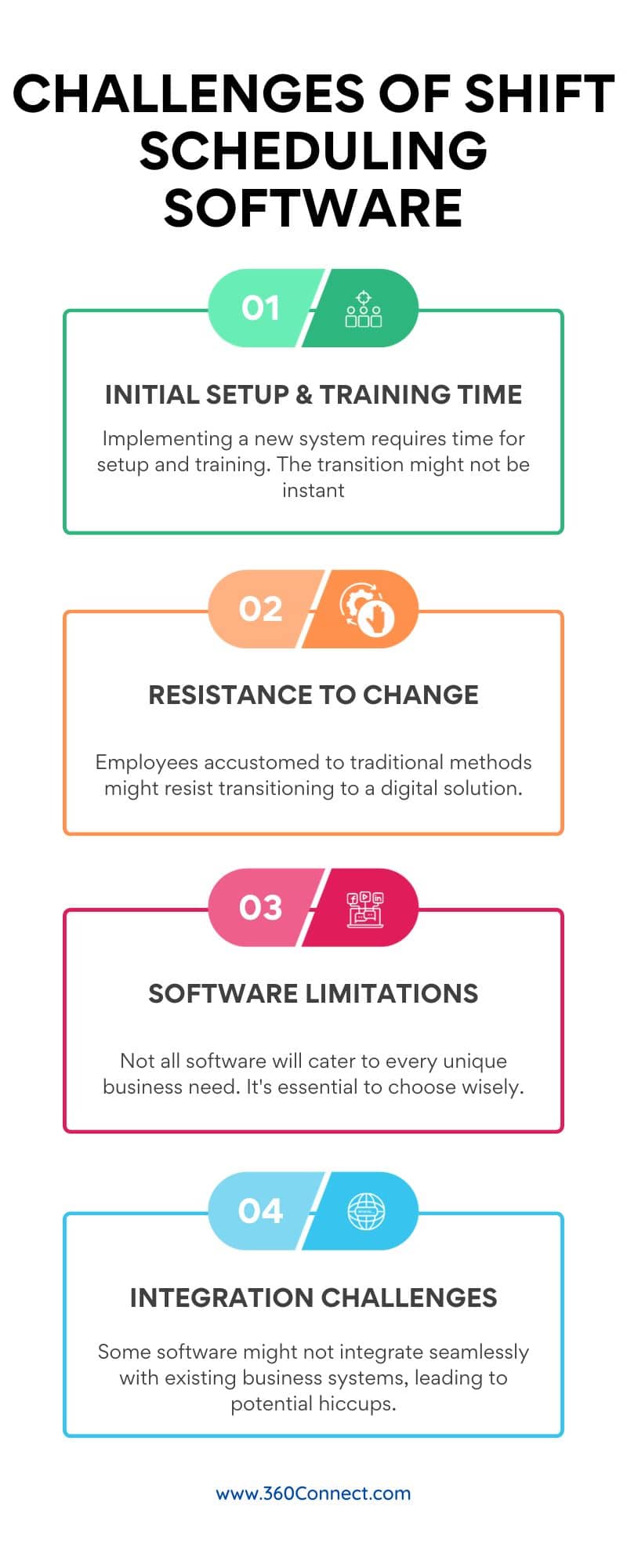Managing staff shifts can be a difficult challenge in today’s fast-paced company environment. Guaranteeing shifts and finding gaps in shifts can be tough without the right tools. Enter shift scheduling software, a cutting-edge solution to these age-old issues. This digital application not only gives a succinct method of managing shifts, but it also includes features that make the entire process easy. Manual scheduling on paper or spreadsheets is a thing of the past.
Shift Scheduling Software:
This software application automatically tracks the number of shifts you have and helps you assign workers to those shifts. The software helps you manage hourly workers and ensure workers show up to work on time to cover their shifts.
How it Works:
Here is a general step-by-step process about how this shift scheduling software works:
Data Input:
Collet details in the software such as:
- Employee details (names, roles, contact information)
- Employee availability (days or hours they can or cannot work)
- Shift requirements (number of employees needed for specific roles or times)
Automatic Schedule Creation:
Based on the input data, the program may automatically produce a timetable that fulfills the goals of the business while taking employee availability and preferences into account.
Manual Adjustments:
While the program can generate schedules automatically, supervisors are usually able to make manual changes. This is useful for dealing with last-minute modifications or special demands.
Employee Access:
Employees often can access the software through their own portal logins on their phone or computer. They can then:
- View their schedules
- Request shift swaps with colleagues
- Apply for leave or indicate unavailability
- Receive notifications about upcoming shifts or changes
- Swap shifts with other members with managerial approval
Reporting & Analytics:
Managers can then look for insights into scheduling trends, labor expenses, overtime, and other variables provided by advanced software systems. This information can assist companies in optimizing staffing and lowering expenditures. These time and attendance systems may also interact with others like HR software to calculate pay, benefits, etc.
Industries that frequently use shift scheduling software:
- Hospitals & clinics
- Hotels & resorts
- Restaurants & cafes
- Stores & warehouses
- Factories
- Emergency services like firefighters, police, and EMS
- Logistic services like airlines, railways, shipping companies
- Call centers
- Security services like private security
- Cinemas & theatres
- Amusement parks
- Maintenance crews
- Cleaning crews
- And much more!
Benefits of Using Shift Scheduling Software
There are many benefits to using shift scheduling software for both business owners and employees. Some of these benefits include:
- Automated scheduling
- Easy access for manager adjustment
- Employee portal to view/change shifts
- Reduction in administrative and manual filing of schedules
- Reduce carbon footprint
- Transparent scheduling
- Avoid scheduling conflicts automatically
- Help spot gaps in shift coverage
- Forecast data for extra/special hours during the busy season due to historical data
- You can minimize the need for overtime
- Reduce errors or missed shifts
- Remote monitoring and access. You can plan shifts while on the go!
While this isn’t the most comprehensive list of the benefits, these are some of the general ones you can expect. If you like to view top providers of shift scheduling software, check out our article here:
Top 5 Time Clock Softwares in 2022
Learn MoreKey Features to Look for in Shift Scheduling Software
Not every shift schedule software is made the same. In fact, the wrong software can be more of a curse than a blessing. Don’t worry, we’ve got your back. Here are some of the top features to look for when conducting your search:
User-friendly Interface:
The software should be simple to use, with a clear interface and simple functions. New users, whether managers or staff, should be able to quickly learn the system.
Mobile Access:
Providers should have apps for both Android and iOS that allow customers to see their schedules, request modifications, and connect with management while on the road. Any changes to the schedule should be reflected immediately on the mobile app, ensuring that everyone is always up to date.
Integration Capabilities:
Integration with HR systems can help to automate activities such as leave management, overtime tracking, and employee data management. Direct interaction with payroll systems provides correct hourly pay, reducing human data entry and errors. Integration can assist in measuring actual hours spent versus scheduled hours, which can help with payroll and performance evaluations.
Notifications and Alerts:
Employees should be notified immediately of impending shifts, shift changes, or any other essential updates. Managers should be able to establish custom alerts, such as reminders for shift beginnings or alerts for understaffing.
Reporting and Analytics:
Managers should have access to data on staffing trends, peak hours, labor expenses, and other topics. They should also be able to develop custom reports to help sift through data. A part of those analytics tools should be the ability to forecast workforce needs in the future.
Employee Self-service:
Employees should be able to specify their preferred shifts in the employee portal. A built-in system for requesting and authorizing time off simplifies the process while also ensuring that all requests are documented. Employees can seek shift swaps with coworkers, subject to managerial approval.

Need Shift Scheduling Software?
Are you looking for shift scheduling software? Don’t worry, we’ve got your back! Just fill out our 1–2-minute form and we’ll contact you to verify your needs and information. From there you can relax and chill as up to 5 suppliers will reach out to you and offer you quotes. It’s that easy.
Get Started Today!

